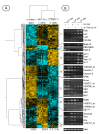Three LIF-dependent signatures and gene clusters with atypical expression profiles, identified by transcriptome studies in mouse ES cells and early derivatives
- PMID: 19203379
- PMCID: PMC2674464
- DOI: 10.1186/1471-2164-10-73
Three LIF-dependent signatures and gene clusters with atypical expression profiles, identified by transcriptome studies in mouse ES cells and early derivatives
Abstract
Background: Mouse embryonic stem (ES) cells remain pluripotent in vitro when grown in the presence of the cytokine Leukaemia Inhibitory Factor (LIF). Identification of LIF targets and of genes regulating the transition between pluripotent and early differentiated cells is a critical step for understanding the control of ES cell pluripotency.
Results: By gene profiling studies carried out with mRNAs from ES cells and their early derivatives treated or not with LIF, we have identified i) LIF-dependent genes, highly expressed in pluripotent cells, whose expression level decreases sharply upon LIF withdrawal [Pluri genes], ii) LIF induced genes [Lifind genes] whose expression is differentially regulated depending upon cell context and iii) genes specific to the reversible or irreversible committed states. In addition, by hierarchical gene clustering, we have identified, among eight independent gene clusters, two atypical groups of genes, whose expression level was highly modulated in committed cells only. Computer based analyses led to the characterization of different sub-types of Pluri and Lifind genes, and revealed their differential modulation by Oct4 or Nanog master genes. Individual knock down of a selection of Pluri and Lifind genes leads to weak changes in the expression of early differentiation markers, in cell growth conditions in which these master genes are still expressed.
Conclusion: We have identified different sets of LIF-regulated genes depending upon the cell state (reversible or irreversible commitment), which allowed us to present a novel global view of LIF responses. We are also reporting on the identification of genes whose expression is strictly regulated during the commitment step. Furthermore, our studies identify sub-networks of genes with a restricted expression in pluripotent ES cells, whose down regulation occurs while the master knot (composed of OCT4, SOX2 and NANOG) is still expressed and which might be down-regulated together for driving cells towards differentiation.
Figures










Similar articles
-
OCT4 supports extended LIF-independent self-renewal and maintenance of transcriptional and epigenetic networks in embryonic stem cells.Sci Rep. 2017 Nov 27;7(1):16360. doi: 10.1038/s41598-017-16611-y. Sci Rep. 2017. PMID: 29180818 Free PMC article.
-
Expression profiling in transgenic FVB/N embryonic stem cells overexpressing STAT3.BMC Dev Biol. 2008 May 23;8:57. doi: 10.1186/1471-213X-8-57. BMC Dev Biol. 2008. PMID: 18500982 Free PMC article.
-
Control of ground-state pluripotency by allelic regulation of Nanog.Nature. 2012 Feb 12;483(7390):470-3. doi: 10.1038/nature10807. Nature. 2012. PMID: 22327294
-
Nanog and transcriptional networks in embryonic stem cell pluripotency.Cell Res. 2007 Jan;17(1):42-9. doi: 10.1038/sj.cr.7310125. Cell Res. 2007. PMID: 17211451 Review.
-
[OCT4 and NANOG are the key genes in the system of pluripotency maintenance in mammalian cells].Genetika. 2008 Dec;44(12):1589-608. Genetika. 2008. PMID: 19178078 Review. Russian.
Cited by
-
The Role of the Leukemia Inhibitory Factor (LIF) - Pathway in Derivation and Maintenance of Murine Pluripotent Stem Cells.Genes (Basel). 2011 Mar 9;2(1):280-97. doi: 10.3390/genes2010280. Genes (Basel). 2011. PMID: 24710148 Free PMC article.
-
Advancements in Antioxidant-Based Therapeutics for Spinal Cord Injury: A Critical Review of Strategies and Combination Approaches.Antioxidants (Basel). 2024 Dec 26;14(1):17. doi: 10.3390/antiox14010017. Antioxidants (Basel). 2024. PMID: 39857350 Free PMC article. Review.
-
Acute depletion of Tet1-dependent 5-hydroxymethylcytosine levels impairs LIF/Stat3 signaling and results in loss of embryonic stem cell identity.Nucleic Acids Res. 2012 Apr;40(8):3364-77. doi: 10.1093/nar/gkr1253. Epub 2011 Dec 30. Nucleic Acids Res. 2012. PMID: 22210859 Free PMC article.
-
Novel role of mitochondrial manganese superoxide dismutase in STAT3 dependent pluripotency of mouse embryonic stem cells.Sci Rep. 2015 Mar 30;5:9516. doi: 10.1038/srep09516. Sci Rep. 2015. PMID: 25822711 Free PMC article.
-
Modeling Mammalian Commitment to the Neural Lineage Using Embryos and Embryonic Stem Cells.Front Physiol. 2019 Jul 11;10:705. doi: 10.3389/fphys.2019.00705. eCollection 2019. Front Physiol. 2019. PMID: 31354503 Free PMC article. Review.
References
-
- Bradley A, Zheng B, Liu P. Thirteen years of manipulating the mouse genome: a personal history. Int J Dev Biol. 1998;42:943–950. - PubMed
Publication types
MeSH terms
Substances
LinkOut - more resources
Full Text Sources
Molecular Biology Databases
Research Materials

